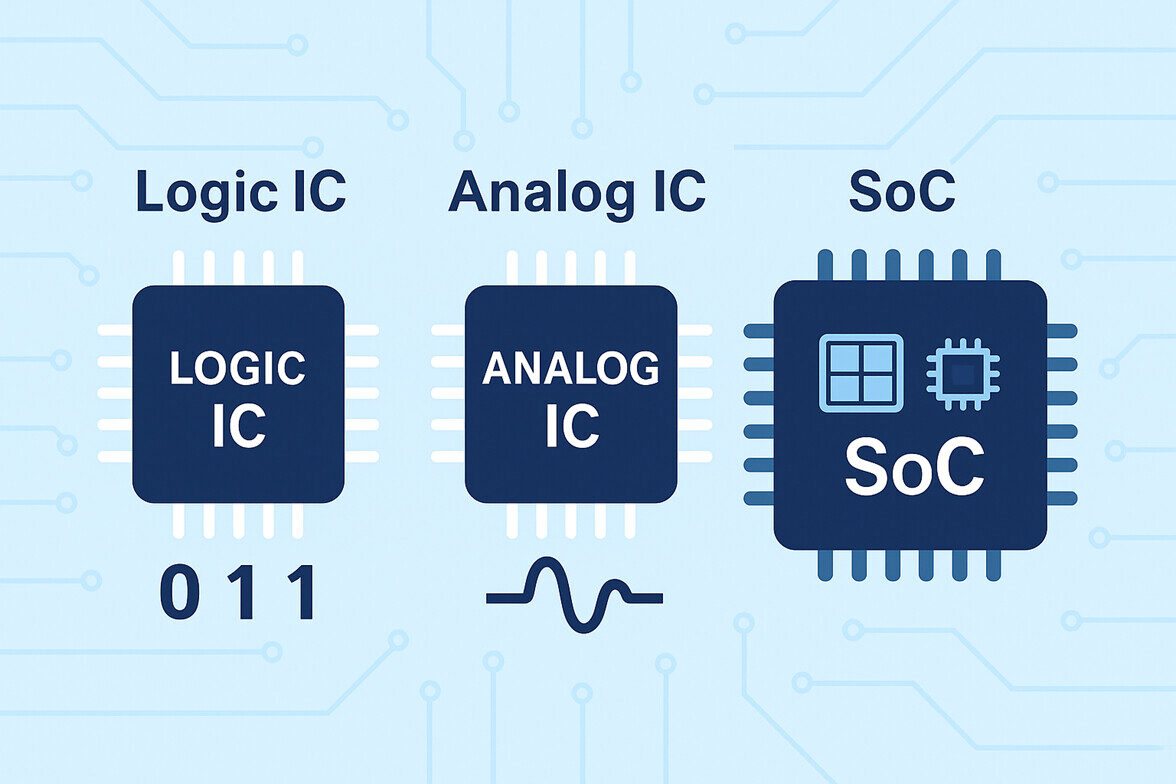
From smartphones and computers to electric vehicles and industrial robots, chips have become the indispensable foundation of modern technology. But have you ever wondered—are all chips the same? In fact, in the field of IC (Integrated Circuit) design, chips can be categorized into several main types based on their purpose and signal type, including Logic IC, Analog IC, and the more highly integrated SoC. This article will walk you through the core concepts and differences among these three chip design approaches.
What Is a Logic IC? The Core Component for Processing Digital Signals
Logic ICs, also known as digital ICs, operate based on binary logic signals— “0” and “1.” These ICs primarily handle logic operations and control functions, including central processing units (CPUs), digital signal processors (DSPs), microcontrollers (MCUs), and memory devices (such as SRAM and DRAM). Information processing, communications, and control functions in modern electronics are almost always executed by Logic ICs.
Logic IC design heavily relies on EDA (Electronic Design Automation) tools and hardware description languages (such as Verilog and VHDL), with a development process that is relatively standardized. Unlike analog design, Logic ICs can be more easily simulated, verified, and mass-produced.
What Is an Analog IC? The Bridge to the Real World
Unlike Logic ICs, Analog ICs process continuously varying “real-world signals,” such as sound, voltage, temperature, and light. For example, audio amplifiers, power management ICs (PMICs), sensor readout circuits, and RF transceiver modules are typical applications of Analog ICs.
Analog IC design depends heavily on circuit design expertise and intuition. With more variables, higher simulation difficulty, and less standardization, analog design often requires experienced engineers to perform manual fine-tuning, making it a discipline that blends both art and engineering.
What Is an SoC? Packing an Entire System into a Single Chip
SoC (System on Chip) combines many functions that used to be in different chips into a single chip. For example, application processors (APs) in smartphones are usually SoCs, integrating CPUs, GPUs, memory controllers, communication modules, image processors, and other subsystems.
The main advantages of SoCs are their compact size, low power consumption, and high system integration, making them especially suitable for mobile devices, wearables, autonomous vehicle AI, and smart home appliances where size and performance are critical.
SoC design typically combines large amounts of digital functionality with small amounts of analog functionality, requiring cross-domain integration such as hardware-software co-design, power management, packaging, and test coordination.
How to Ensure Chip Quality
Whether it’s a Logic IC, Analog IC, or SoC, all chip designs face the same challenge after completion—how to ensure quality. This includes verifying functional correctness, memory stability, and compliance with automotive or industrial standards.
iSTART-TEK provides complete DFT (Design-for-Testability) and BIST (Built-In Self-Test) solutions, enabling design teams to implement testability structures from the RTL stage, effectively improving testing efficiency and chip reliability. For memory, iSTART-TEK’s SRAM testing and repair tool START™, powered by UDA + TEC algorithms, achieves high coverage and low false detection rates—widely used in AI, automotive, and communications sectors where reliability is critical.
Whether designing a CPU, power management IC, or the next-generation SoC platform, iSTART-TEK can implement the optimal testing strategy to bring innovative designs to life.
